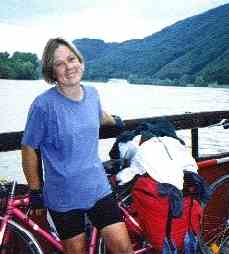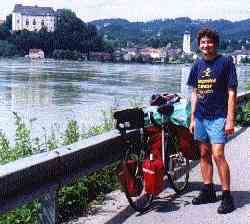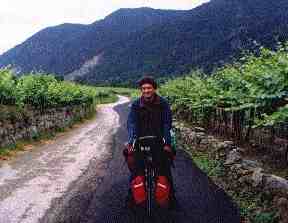This classic route offers seamless cycling on flat and (mostly) tarmaced and traffic-free surfaces.
The documented highlights are the Danube Bend (Donau Knie – knee, in English) not far from Bratislava and the Schloegener Schlinge, another sweeping curve, around 40km east of Passau but which is best seen from the top of the hill or a postcard! And despite the famous tune, the Danube ain't blue. On a more serious theme you can visit the former concentration camp outside the pretty village of Mauthausen.
The route is often wide enough (number of oncoming/ overtaking cyclists permitting) to pedal side-by-side. People are very friendly and if you are carrying camping equipment, often curious enough to stop you and talk – most cyclists you see have just what they need for that day, staying in hotels or guesthouses between which their luggage is transported for them.
70 per cent are Germans; most are professionals. 'I'm responsible for France', as one told us, although he declined to elaborate why. Most are there because they have 'desk jobs and want exercise' during their holidays, and almost all have come on the recommendation of friends and relatives. They aren't disappointed and neither will you be.
In the summer months there are cycle path-side stalls with accommodation details for the immediate area and for as far as Vienna. The service is free and friendly! (Tip, if you are going as far as Bratislava or beyond, stay an extra night in Austria, sightsee 'Brat' in the morning and escape to Hungary in the afternoon. Brat has few hotels, and those it does have are priced from expensive to extortionate and all very hard to locate. We never did find the campsite!)
There is often a route on both sides of the Danube and nothing to tell you which is best, but all meet up with the river again sooner or later and the signposting is so good it's almost impossible to lose your way. On long stretches the route misses the villages so if you want a coffee, a beer or an icecream you need to work out where you are on your map in relation to the nearest habitation and come off the path. But it's worth it. The villages are charming and everywhere is so clean.
As you pedal, look for posters advertising festivals, especially Sonnenwendfeier (celebrations with fireworks on the longest day) and Fruehschoppen (Sunday morning live, traditional music at which food and drink is available).
There's no need to take your own bike… In Germany and Austria you can hire bikes (child's bike around GBP22.50/15* per week, 'citybike' GBP 35/22* per week, MTBs cost one-third more and child seats GBP3.50/3* per week) from all major rail stations, and if you have arrived by train you get a substantial discount*. (See the , Austrian Railways web site or e-mail: rentabike@aon.at. See also the German Railways web site). And you can return your bike in either country, at any rail station with cycle hire and pay a very small sum, just a couple of pounds, for the privilege.
If you are on your own bike, in summer there's a daily coach service between Vienna and Passau which carries cyclists and their cycles. Bikes travel free on the boats plying the Danube…Most trains carry bikes for a small fee.

 Wonderful scenery, flat smooth well signposted route, lots of inexpensive and high quality places to stay and eat, and lots of fellow cyclists to chat to. Much like cycling in England, except for the flat/ smooth/ well signposted/ inexpensive/ high quality bit.
Wonderful scenery, flat smooth well signposted route, lots of inexpensive and high quality places to stay and eat, and lots of fellow cyclists to chat to. Much like cycling in England, except for the flat/ smooth/ well signposted/ inexpensive/ high quality bit. This bit was Grein, one of the many beautiful towns en route where all the houses look like cakes.
This bit was Grein, one of the many beautiful towns en route where all the houses look like cakes.